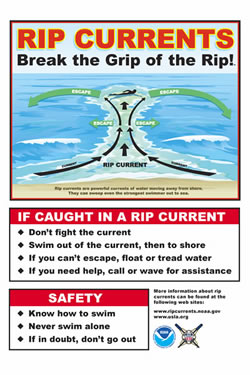 Rip currents are powerful, channeled currents of water flowing away from shore. They typically extend from the shoreline, through the surf zone, and past the line of breaking waves. Rip currents can occur at any beach with breaking waves, including the Great Lakes. Rip currents are powerful, channeled currents of water flowing away from shore. They typically extend from the shoreline, through the surf zone, and past the line of breaking waves. Rip currents can occur at any beach with breaking waves, including the Great Lakes.
Rip currents can be killers. The United States Lifesaving Association estimates that the annual number of deaths due to rip currents on our nation's beaches exceeds 100. Rip currents account for over 80% of rescues performed by surf beach lifeguards.
The greatest safety precaution that can be taken is to recognize the danger of rip currents and always remember to swim at beaches with lifeguards. The United States Lifesaving Association has calculated the chance that a person will drown while attending a beach protected by USLA affiliated lifeguards at 1 in 18 million. If caught in a rip current at an unguarded beach, how
you respond could make the difference between life and death.
NOAA's National Weather Service and National Sea Grant Program, in partnership with the United States Lifesaving Association, are working together to raise awareness about the dangers of rip currents. Research is also being conducted in order to develop and improve the ability to predict the occurrence and strength of rip currents. The goal of the awareness campaign and research is to reduce the number of rip current related fatalities.
A daily rip current outlook is included in the Surf Zone Forecast, which is issued by many National Weather Service offices. A three-tiered structure of low, moderate, high is used to describe the rip current risk. This outlook is communicated to lifeguards, emergency management, media and the general public.
With increasing coastal populations, rip currents will continue to be a serious hazard at surf beaches. This web site is designed to provide educational material as well as real time information about the rip current risk. The time you take to understand rip currents can help you protect yourself and your loved ones when visiting the beaches.


   |


